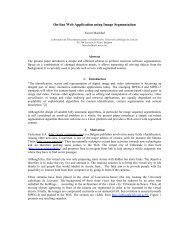motion estimation and compensation for very low bitrate video coding
motion estimation and compensation for very low bitrate video coding
motion estimation and compensation for very low bitrate video coding
Create successful ePaper yourself
Turn your PDF publications into a flip-book with our unique Google optimized e-Paper software.
3.2 Distributed Version of the Local Motion Estimation 91<br />
gated" states because the previous iteration <strong>for</strong> these neighbors has not<br />
completed yet. One has to wait <strong>for</strong> \Propagated" blocks to fall into the<br />
\Done" or \Split" state ( gure 3.7). In the latter case, the transition<br />
condition is determined by the appropriate subblock.<br />
Similarly to what has just been presented, the non-linear ltering of a<br />
block (<strong>and</strong> the decision algorithm) can start as soon as its 8 neighbors are<br />
either in the \Propagated" state, either in the \Done" or \Split" state.<br />
In e<strong>very</strong> case, it is the vector value resulting from the \Propagated" state<br />
that is to be used. Once again, some neighbor blocks can have a larger<br />
size. They can only be neighbors via the diagonal because horizontal<br />
<strong>and</strong> vertical blocks had to be over the \Propagated" state during the<br />
previous step. One has to wait until such larger blocks fall into the<br />
\Done" or \Split" state.<br />
So as to somehow complete this in<strong>for</strong>mal description of the transition<br />
conditions, some additional properties should be described. Figure 3.8<br />
presents an impossible situation where a block has as neighbors bigger<br />
blocks in \Known" or \Unknown" state. This case is impossible because<br />
the block undergoing treatment results from a bigger block that has<br />
been split after the <strong>motion</strong> certitude treatment <strong>and</strong> the ltering (what<br />
implies that all its neighbors were at least in the \Propagated" state).<br />
P<br />
P<br />
K<br />
Figure 3.8: Impossible situation<br />
But there can be more than one di erence of size between two neighbor<br />
blocks. If it is the case, the biggest blocks must absolutely be in the<br />
\Done" state as illustrated on gure 3.9.<br />
To achieve the practical implementation, Vermaut has developed all the<br />
necessary structures to manage the block data <strong>and</strong> to keep in memory<br />
the block position in the image, its size, its present state <strong>and</strong> related<br />
in<strong>for</strong>mation, <strong>and</strong> a list of neighbors. E cient ways of per<strong>for</strong>ming the<br />
wakening of a block have also been erected.





